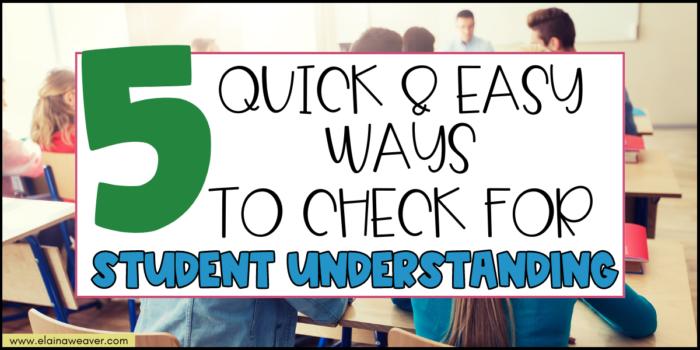Have you ever felt uninspired when it comes time to check for student understanding? Perhaps you have found yourself in the middle of a lesson and needing to gauge whether or not your students are grasping this new concept the way you hoped. Things are flowing pretty well, and you don’t want to interrupt the flow with a written assessment, but you are tired of the same check-ins with your students.
You want something quick, easy, and engaging. Something you can use in the middle of the lesson for immediate feedback before proceeding.
Friend, you are in the right place. I’m Elaina, The Classy Teacher, and I’m sharing my five favorite quick and easy ways to check for student understanding.

Strategies to Check for Student Understanding
As teachers, we spend plenty of time grading student work. Blending formative assessments throughout our lessons should not result in more student work for us to grade. We have to work smarter, not harder. Students don’t need to solve multiple problems to show their level of understanding. They can demonstrate their comprehension without solving even one problem. We only need to ask the right questions and provide the correct prompts for our students.
I will help you get started in this post by sharing five quick and easy strategies, but if you want even more ideas, I have 25 prompts to use in your middle school math classroom. My Writing Prompts for Math help you build self-awareness in your students through sentence frames designed specifically for math.
Help your students start assessing their own learning with these free 25 Writing Prompts for Math.
Student Self Assessment in Math
One of the best things you can do, in my opinion, to create opportunities for checking for student understanding is to help your students become self-aware in their learning. Let your students formally assess themselves for you. Again I say work smarter, not harder.
I like to do this using a set of posters that show the different levels of understanding. In the beginning, some students will struggle with accurately identifying where they are, but the more they practice doing this, the more self-aware they become.
Sometimes I have the entire class close their eyes and show me their level of understanding with their fingers. Another option is to write their level on the top of their paper by their name or even provide them with an exit ticket that asks them to rate their understanding.

But my favorite option is to have them turn in their assignment based on their level of understanding.
I write the different levels on our counter with a dry erase marker, and students place their paper on the counter under the level they feel best identifies their level of understanding. Doing this is especially helpful as I look through the assignments and create small groups or differentiated activities based on their understanding. Because they have already sorted them for me, I spend less time figuring out small groups. While this process is a bit rocky at first as they learn to honestly and accurately evaluate their level of understanding, it tends to smooth out the more they practice.
Ideas to Check for Student Understanding
Now that you have some overall strategies running through your mind, let’s talk specifics. I promised you five quick and easy ways to formally assess your students and it’s time I delivered.
Here we go.
Turn and Talk
We all know most middle school students love to talk. Why not give them a purpose for all that chatter? Have your students turn and share how they solved a problem with their classmate. While all that wonderful math talk is happening, you can walk around the room listening and watching. Are there students who aren’t talking about math? Maybe some aren’t talking at all. Are they asking each other questions? If several students seem lost you can address the topic as a class. If only a few seem to be struggling you can work with those students in a small group or one on one.
Fist to Five
This one is a personal favorite because it helps students take ownership of their own learning. They show you how well they think they understand on a scale of 0 (fist) to 5. Are they completely lost? 👊🏼 or do they have it and could easily teach someone else? 🖐️ This one only takes a few seconds and gives an overall view of how your class is doing.
Next Step
Begin working a problem as a class on the board. When you reach the moment when several students might make a mistake, stop. Ask them about which step comes next, giving them choices to choose from. Similar to fist to five, have students answer using their fingers. For example, show me a one if you believe the next step is to add five. Show me a two if you believe the next step is to subtract five. This form of formative assessment quickly lets you know if there are common misconceptions among your students.
Two Truths and a Lie
We all know this game from those awkward professional development introductions. Normally you are making up two truths and a lie about yourself. But what if the three statements were about the topic you were teaching instead? Students have to determine which statement is the lie. If you can throw in a common misconception or two, it can really show you where students are in their understanding. If you have a bit more time, you could have the students come up with their own three statements. Share them with the class and let the class “solve” those.
Four Corners
If you want to add movement to your lesson, this one is for you. Hang four “posters” around your room. They could say A, B, C, and D or you could use a likert scale and have phrases like Strongly Agree and Disagree. (Bonus points if you choose some fun astrobright paper to print your posters) Next, pose a question or statement and have students go stand by the poster that indicates their answer. This activity can often lead to good conversations and debates. I have to admit I think I saved the best for last. Four Corners is probably my favorite way to check for student understanding. At least it is in the top tree.


One Response